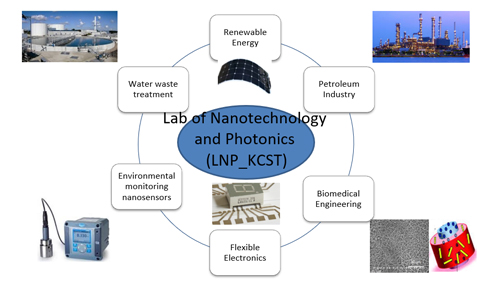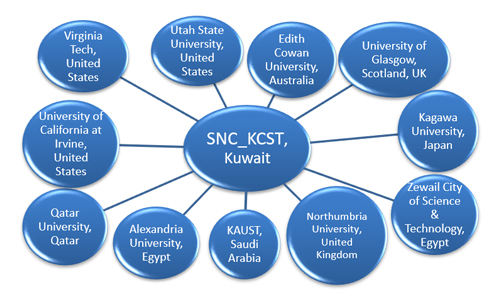

The recently established Kuwait College of Science and Technology (KCST) aims to be one of the best academic institutes in Gulf area in both teaching and research tracks. At KCST, we have a promising research interest through the integration between multidisciplinary areas including Electrical Engineering, Computer Science/Engineering, Applied Physics, and Material Science. Therefore, KCST starts to build Nanotechnology and Photonics Lab “LNP” to be one of the pioneer research centers, whether in State of Kuwait and the Gulf area, within the field of nanotechnology and its related wide applications of different disciplines.
LNP is mainly concerned with the synthesis and characterization of different optical and conductive nanostructures, so that it can be applied further in wide variety of applications such as environmental nanosensors, new trends in renewable energy, flexible printed electronics, water-waste treatment, petroleum industry, biomedical engineering, and Internet of Things (IoT). Moreover, LNP at KCST targets to build innovative prototypes in the aforementioned applications to serve both governmental and private sectors inside the State of Kuwait. Also, LNP has strong collaboration connections through different research centers in United States, United Kingdom, Australia, Japan, Saudi Arabia, Egypt, and Qatar. On the other hand, the targeted facilities and manpower at LNP can help the professors of KCST to obtain some preliminary results, which can be the basic seed to apply for further research proposals within both Kuwaiti and international funding agencies.
Regarding the educational perspective, the planned facilities of LNP are essential for KCST’s talented students to develop their background/skills and consequently to turn their brilliant ideas into possible prototypes, which to be applied further in entrepreneurship competitions and open the window of small business plans for them.
Our vision in KCST is to develop LNP to be a leader research lab in State of Kuwait, and Gulf area in general, in the fields of nanotechnology with integrated multi-disciplinary fields such as petroleum industry, environmental monitoring, water waste treatment, renewable energy, communications, electronics and cyber security. We aim to offer high quality research, to make the center competitive with similar centers worldwide. Also, this center can be a focal point for international collaboration and research funds in the aforementioned fields, which strongly serves both Kuwaiti governmental and private industrial sectors. In a related track, we target to make LNP is an ideal research environment for Kuwaiti young researchers including both graduate and undergraduate students.
Our strategy inside LNP at KCST (LNP_KCST) is to depend on low and moderate-cost facilities to synthesize and characterize nanostructures followed by designing and fabricating simple prototypes. LNP aims to be an optimum collaborative research center that can be the leader in the domain of Smart nano-scale research not only on the national scale but also across the Gulf area and the entire Middle East region. With the successful utilization of the center facilities and latest communication technologies that we have, we shall enable border crossing collaboration with researchers and research centers opening the way for large-scale research projects. Meanwhile, we collaborate with other research centers, whether inside or outside Kuwait, to use their high-cost nanostructures characterization facilities.
Inside LNP_KCST, our target is to match our research interests within both the national Kuwaiti research interests for including renewable energy, biomedical engineering, environmental monitoring, petroleum industry, and waste treatment. This would make the university to be within a solid contact with some governmental ministries. In addition, our vision is to build a strong connection within the private sector through initiating industrial partnership with companies especially in petroleum, communications, biomedicine, and textile fields. Our research center can initiate promising prototypes , depending on the successful development of different synthesized nanostructures, and turning these prototypes into products for both Kuwaiti and international markets.

Our research interests can be integrated, but not limited to, with the following fields which are of major importance inside State of Kuwait…

Moreover, KCST researchers have strong international connections for collaborators worldwide, as shown in Figure 2. This promising collaboration can support LNP_KCST to be an important focal point of nanotechnology in Gulf area well-connected to the international nanotechnology prestigious research centers.
Regarding the educational track, the built research school at KCST would be helpful for Kuwaiti undergraduates to teach them more about the scientific research, develop some research skills, and participate within some research activities. Overall, all of these research and educational outcomes can increase the awareness in the Kuwaiti society about the importance of academic research and how it can be helpful for the development of the country.
| Lab’s director : Dr. Nader Shehata |
| Co-Director : Dr. Ishac Kandas |
| Email : LNP@kcst.edu.kw, |
| Phone : 6501-9574 |